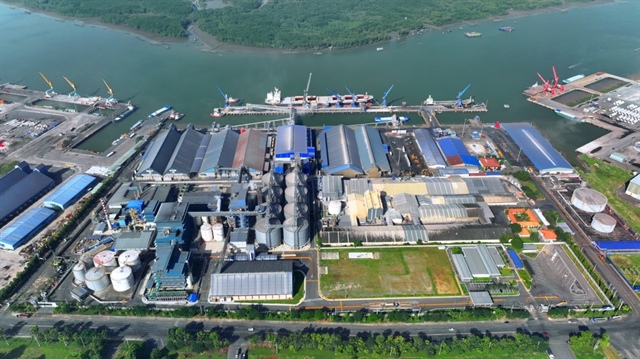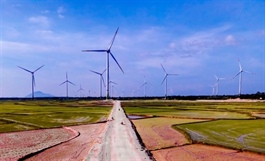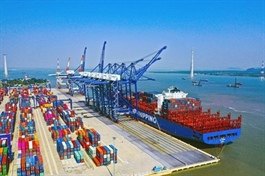US, Vietnam buy 50.2% of Jan-Apr exports
US, Vietnam buy 50.2% of Jan-Apr exports
The US and Vietnam together held a 50.20 per cent market share of Cambodia’s goods exports in the first four months of 2023, making them the Kingdom’s top two destinations in that order for the fourth consecutive January-April period, according to Customs (GDCE) data compiled in “International Merchandise Trade Statistics” bulletins.
Although a slight dip from a 51.29 per cent market share a year earlier, this marks considerable jumps from the 30.95 per cent and 23.66 per cent recorded in the same periods of 2015 and 2017, respectively. According to the bulletins, which only cover 2015-2023, this is only the second January-April period where this percentage has exceeded 50 per cent.
In January-April 2023, Cambodia exported goods to the tune of $7.234 billion – down 4.89 per cent year-on-year from $7.606 billion – of which $3.631 billion went to the US or Vietnam, which was down 6.91 per cent on an annual basis from $3.901 billion.
Individually, Cambodia’s exports to the US and Vietnam amounted to $2.450 billion and $1.181 billion, respectively, down 16.20 per cent and up 20.89 per cent year-on-year from $2.924 billion and $977.270 million. The US and Vietnam bought 33.87 per cent and 16.33 per cent of the Kingdom’s total exports.
In April alone, exports to the two countries totalled $898.58 million – down 9.43 per cent year-on-year from $992.17 million – representing 48.78 per cent of the total $1.842 billion in exports for the month, which was down 2.51 per cent from $1.889 billion.
‘Constant growth’
Cambodia Chamber of Commerce (CCC) vice-president Lim Heng commented to The Post on May 25 that the US and Vietnam have long been top Cambodian export targets, considerably contributing to economic growth.
The US is the largest market for Cambodian garments, footwear and travel goods, while Vietnam is a prominent buyer of the Kingdom’s agricultural and unprocessed products, he said.
The world’s largest economy “has long been a major market for Cambodian textiles, and exports there have essentially been growing constantly, till about a year ago.
“And due to its border with Cambodia and extensive processing industries, Vietnam consistently imports sizeable quantities of agricultural goods from Cambodia each year,” Heng said.
The volume of trade between Cambodia and these two countries is projected to rise, especially as the global economy improves, he noted.
Although the volume of merchandise exchanged between the Kingdom and the other two nations fell 7.04 per cent on-year in January-April 2023, trade rocketed from $3.480 billion in full-year 2015 to $15.417 billion in 2022, growing at a compound annual growth rate (CAGR) of 23.69 per cent, according to the GDCE.
Royal Academy of Cambodia economics researcher Ky Sereyvath stated that the Kingdom’s imports and exports, especially those involving the US, Vietnam or other major trading partners, should rise if the global political climate improves and the world economy stabilises and recovers.
The US and Vietnam are primary import and export markets, he said, highlighting that the former provides Cambodia with preferential tariffs, and that the bordering country has had long-standing trade ties with the Kingdom.
“The US and Vietnam are Cambodia’s main export markets, and trends will improve once the global economy is back on the road to recovery,” Sereyvath said.
Regardless, he suggested the Kingdom strive to strengthen and expand its production and processing capacity and look into potential new target markets.
He also remarked that the US and Vietnam are leading import sources for the Kingdom, notably its neighbour.
According to the GDCE, Cambodia imported $1.324 billion worth of goods from the two countries in the first four months of 2023 – down 7.39 per cent year-on-year from $1.430 billion – comprising 16.70 per cent of total imports for the period.
Individually, imports from the US and Vietnam clocked in at $75.004 million and $1.249 billion, down 28.14 per cent and down 5.76 per cent year-on-year from $104.380 million and $1.325 billion. Vietnam was the Kingdom’s second largest import source for the period, after mainland China ($3.454 billion).
The breakdown
No breakdown was immediately available of the specific items traded between Cambodia and the other two countries at any point during 2022-2023.
However, Trading Economics statistics show that, out of Cambodia’s $7.49 billion worth of goods exports to the US in 2021, “articles of apparel, knit or crocheted” accounted for the lion’s share at $2.21 billion (versus $1.75B in 2020), followed by “articles of leather, animal gut, harness, travel goods” ($1.26B; vs $773.97M), “furniture, lighting signs, prefabricated buildings” ($832.76M; vs $611.96M), and “articles of apparel, not knit or crocheted” ($773.97M; vs $677.20M).
The next eight items were: “electrical, electronic equipment” ($548.03M; vs $281.26M in 2020), “footwear, gaiters and
the like” ($498.98M; vs $300.95M), “plastics” ($356.73M; vs $274.92M), “wood and articles of wood, wood charcoal” ($310.75M; vs $203.81M), “vehicles other than railway, tramway” ($271.19M; vs $153.21M), “other made textile articles, sets, worn clothing” ($88.91M; vs $60.00M), “toys, games, sports
requisites” ($55.55M; vs $47.95M), and “residues, wastes of food industry, animal fodder” ($39.39M; vs $19.93M).
For reference, the 12 categories respectively correspond to chapters 61, 42, 94, 62, 85, 64, 39, 44, 87, 63, 95 and 23 of the Harmonised System (HS) of Tariff Nomenclature.
Similarly, out of the Kingdom’s $507.65 million worth of goods exports to Vietnam in 2021, “rubbers” accounted for the most at $289.02 million (versus $202.80M in 2020), followed by “sugars and sugar confectionery” ($48.90M; vs $52.49M), “knitted or crocheted fabric” ($25.94M; vs $17.95M), and “electrical, electronic equipment” ($22.09M; vs $19.05M).
The next eight items were: “articles of apparel, knit or crocheted” ($20.35M; vs $33.83M in 2020), “coffee, tea, mate and spices” ($17.89M; vs $3.26M), “footwear, gaiters and the like” ($6.87M; vs $7.90M), “ships, boats, and other floating structures” ($6.24M), “lead” ($5.97M), “clocks and watches” ($5.95M; vs $5.83M), “tobacco and manufactures tobacco substitutes” ($5.95M; vs $5.67M), and “salt, sulphur, earth, stone, plaster, lime and cement” ($5.58M; vs $882.55K).
These 12 categories respectively correspond to chapters 40, 17, 60, 85, 61, 09, 64, 89, 78, 91, 24 and 25 of the HS.
The economic data provider notes that its figures are sourced from the UN Commodity Trade Statistics Database (UN COMTRADE).


























